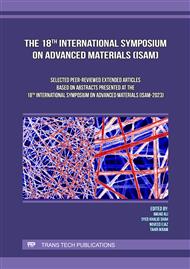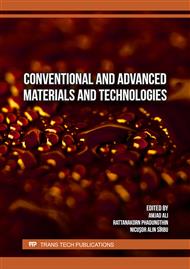[1]
Y. Long, B. He, W. Cui, Y. Ji, X. Zhuang, J. Twiefel, Investigations on the mechanism of microweld changes during ultrasonic wire bonding by molecular dynamics simulation, Mater. Des. 192 (2020) 108718. https://doi.org/.
DOI: 10.1016/j.matdes.2020.108718
Google Scholar
[2]
L. Zhang, Z. Liu, S.-W. Chen, Y. Wang, W.-M. Long, Y. Guo, S. Wang, G. Ye, W. Liu, Materials, processing and reliability of low temperature bonding in 3D chip stacking, J. Alloys Compd. 750 (2018) 980–995. https://doi.org/.
DOI: 10.1016/j.jallcom.2018.04.040
Google Scholar
[3]
H. Park, H. Seo, Y. Kim, S. Park, S.E. Kim, Low-Temperature (260 °C) Solderless Cu–Cu Bonding for Fine-Pitch 3-D Packaging and Heterogeneous Integration, IEEE Trans. Components, Packag. Manuf. Technol. 11 (2021) 565–572.
DOI: 10.1109/TCPMT.2021.3065531
Google Scholar
[4]
Y.-P. Huang, Y.-S. Chien, R.-N. Tzeng, K.-N. Chen, Demonstration and Electrical Performance of Cu–Cu Bonding at 150 °C With Pd Passivation, IEEE Trans. Electron Devices. 62 (2015) 2587–2592.
DOI: 10.1109/TED.2015.2446507
Google Scholar
[5]
G. Li, Q. Kang, F. Niu, C. Wang, Recent progress on bumpless Cu/SiO2 hybrid bonding for 3D heterogeneous integration, Microelectron. Int. 40 (2023) 115–131.
DOI: 10.1108/MI-07-2022-0121
Google Scholar
[6]
G. Gao, L. Mirkarimi, G. Fountain, L. Wang, C. Uzoh, T. Workman, G. Guevara, C. Mandalapu, B. Lee, R. Katkar, Scaling Package Interconnects Below 20µm Pitch with Hybrid Bonding, in: 2018 IEEE 68th Electron. Components Technol. Conf., 2018: p.314–322.
DOI: 10.1109/ECTC.2018.00055
Google Scholar
[7]
C.C. Hu, M.F. Chen, W.C. Chiou, D.C.H. Yu, 3D Multi-chip Integration with System on Integrated Chips (SoICTM), in: 2019 Symp. VLSI Technol., 2019: pp. T20–T21.
DOI: 10.23919/VLSIT.2019.8776486
Google Scholar
[8]
Y. Kagawa, N. Fujii, K. Aoyagi, Y. Kobayashi, S. Nishi, N. Todaka, S. Takeshita, J. Taura, H. Takahashi, Y. Nishimura, K. Tatani, M. Kawamura, H. Nakayama, T. Nagano, K. Ohno, H. Iwamoto, S. Kadomura, T. Hirayama, Novel stacked CMOS image sensor with advanced Cu2Cu hybrid bonding, in: 2016 IEEE Int. Electron Devices Meet., 2016: p.8.4.1-8.4.4.
DOI: 10.1109/IEDM.2016.7838375
Google Scholar
[9]
S. Khan, M. Junaid, T. Shehbaz, F.N. Khan, Influence of Cu interlayer on the interfacial strengthening of the diffusion-bonded SS-304L/IN718, Mater. Lett. 358 (2024) 135829. https://doi.org/.
DOI: 10.1016/j.matlet.2023.135829
Google Scholar
[10]
S. Kundu, G. Thirunavukarasu, Diffusion Welding of Ti6Al4V and 17-4 Stainless Steel Using Cu/Ni Microlayers, J. Mater. Eng. Perform. (2022).
DOI: 10.1007/s11665-022-07101-y
Google Scholar
[11]
S. Khan, Khadija, M. Junaid, T. Shehbaz, F. Nawaz Khan, N. Naveed, Evaluation of nano indentation behavior of TIG, MIG and diffusion bonded Inconel 718 and austenitic Stainless Steel 316L joint interface, Mater. Lett. (2024) 136952. https://doi.org/.
DOI: 10.1016/j.matlet.2024.136952
Google Scholar
[12]
M. Elsa, A. Khorram, O.O. Ojo, M. Paidar, Effect of bonding pressure on microstructure and mechanical properties of aluminium/copper diffusion-bonded joint, Sadhana - Acad. Proc. Eng. Sci. 44 (2019) 1–9.
DOI: 10.1007/s12046-019-1103-3
Google Scholar
[13]
S. Khan, Z. Ali, K. Rehman, M. Junaid, Mechanical and Microstructural Characterization of Diffusion-Bonded Copper-Nickel Joint Interface, Adv. Mater. Res. 1179 (2024) 147–155.
DOI: 10.4028/p-k8wUUO
Google Scholar
[14]
T. Lin, C. Li, X. Si, X. Li, B. Yang, J. Feng, J. Cao, An investigation on diffusion bonding of Cu/Cu using various grain size of Ni interlayers at low temperature, Materialia. 14 (2020) 100882.
DOI: 10.1016/j.mtla.2020.100882
Google Scholar
[15]
H. Tatsumi, C.R. Kao, H. Nishikawa, Impact of crystalline orientation on Cu – Cu solid ‑ state bonding behavior by molecular dynamics simulations, Sci. Rep. (2023) 1–10.
DOI: 10.1038/s41598-023-50427-3
Google Scholar
[16]
C. Liu, H. Lin, Y. Huang, Y. Chu, C. Chen, D. Lyu, K. Chen, K. Tu, Low-temperature direct copper-to- copper bonding enabled by creep on ( 111 ) surfaces of nanotwinned Cu, Nat. Publ. Gr. (2015) 1–11.
DOI: 10.1038/srep09734
Google Scholar
[17]
K. Shie, A.M. Gusak, K.N. Tu, C. Chen, A kinetic model of copper-to-copper direct bonding under thermal compression, (2021).
DOI: 10.1016/j.jmrt.2021.09.071
Google Scholar
[18]
X.-G. Wang, X.-G. Li, C.-G. Wang, Influence of diffusion brazing parameters on microstructure and properties of Cu/Al joints, J. Manuf. Process. 35 (2018) 343–350. https://doi.org/.
DOI: 10.1016/j.jmapro.2018.08.020
Google Scholar
[19]
H.-W. Hu, K.-N. Chen, Development of low temperature CuCu bonding and hybrid bonding for three-dimensional integrated circuits (3D IC), Microelectron. Reliab. 127 (2021) 114412. https://doi.org/.
DOI: 10.1016/j.microrel.2021.114412
Google Scholar
[20]
D.K. Dwivedi, Joining of Dissimilar Metals by Diffusion Bonding BT - Dissimilar Metal Joining, in: D.K. Dwivedi (Ed.), Springer Nature Singapore, Singapore, 2023: p.245–267.
DOI: 10.1007/978-981-99-1897-3_9
Google Scholar
[21]
M. Samouhos, A. Peppas, P. Angelopoulos, M. Taxiarchou, P. Tsakiridis, Optimization of copper thermocompression diffusion bonding under vacuum: Microstructural and mechanical characteristics, Metals (Basel). 9 (2019).
DOI: 10.3390/met9101044
Google Scholar
[22]
C. Zhang, A.A. Shirzadi, Diffusion bonding of copper alloy to nickel-based superalloy: effect of heat treatment on the microstructure and mechanical properties of the joints, Sci. Technol. Weld. Join. 26 (2021) 213–219.
DOI: 10.1080/13621718.2021.1882653
Google Scholar
[23]
T. Gietzelt, V. Toth, A. Huell, Diffusion Bonding: Influence of Process Parameters and Material Microstructure, Join. Technol. (2016).
DOI: 10.5772/64312
Google Scholar
[24]
S. Sebastian, V.A. Suyamburajan, Microstructural analysis of diffusion bonding on copper stainless steel, Mater. Today Proc. 37 (2020) 1706–1712.
DOI: 10.1016/j.matpr.2020.07.244
Google Scholar



